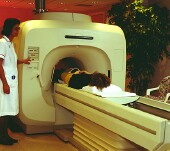
WEDNESDAY, March 31 (HealthDay News) — Fears that popular medical imaging technologies are exposing Americans to too much radiation are getting a public airing this week as the U.S. Food and Drug Administration concludes two days of meetings on Wednesday that have focused on how to increase the safety of these procedures.
Specifically, the agency is seeking ideas to get manufacturers of the devices used for CT scans and fluoroscopy to set higher standards for their equipment and increase the amount of training they offer those who use the equipment.
The aim is to “help reduce unnecessary patient exposure to ionizing radiation” during these procedures, the FDA said. The imaging techniques, which are two of the top three contributors to total radiation exposure among Americans, use much higher radiation doses than standard X-rays, dental X-rays and mammography, potentially increasing the lifetime risk for cancer.
In addition, accidental radiation exposure can result in injuries, such as burns, hair loss and cataracts.
Dr. Jorge Guerra Jr., a professor of radiology at the University of Miami Miller School of Medicine, agreed that manufacturers need to “give us the best equipment [and] teach us how to use it properly.” Scanning should only be done by trained professionals, he stressed.
But, Guerra, said, “it’s the overuse of CT that’s really killing it.” There need to be clearer guidelines for the use of CT and other radiological devices, he said, including specific criteria on who should be getting scans for what particular conditions.
“Yes, there is an increased risk of cancer in the general population from the overuse of radiation,” he said. “Let’s work on cutting down on the overuse of radiation — not cutting out the technology.”
According to the U.S. National Cancer Institute, about 70 million CT scans are now done in the United States each year. In the early 1980s, only 3 million were done annually. The institute also estimates that up to 14,000 people die every year from radiation-induced cancers.
“The amount of radiation Americans are exposed to from medical imaging has dramatically increased over the past 20 years,” Dr. Jeffrey Shuren, director of the FDA’s Center for Devices and Radiological Health, said in a statement released in February when the agency unveiled a plan to increase communication between doctors and patients about the pros and cons of medical imaging. “The goal of FDA’s initiative is to support the benefits associated with medical imaging while minimizing the risks.”
Though the extent of a cancer risk remains a topic of debate, most experts agree that exposure to unnecessary radiation from these devices should be reduced. The radiation from a CT scan of the abdomen equals that of about 400 chest X-rays, and a dental X-ray has about half the radiation of a chest X-ray, according to the FDA.
An article in the March 28 edition of The New York Times reported that the FDA ignored warnings from its scientists about the risks of routinely using CT scans to screen people for colon cancer, a procedure sometimes called a virtual colonoscopy.
After an FDA official recommended approving the application for a device made by General Electric, Dr. Julian Nicholas, a gastroenterologist who worked under contract with the FDA, said he felt strongly that approving the application could “expose a number of Americans to a risk of radiation that is unwarranted and may lead to instances of solid organ abdominal cancer,” according to the Times report.
Nicholas, who now works as a doctor at the Scripps Clinic in San Diego, told The Times that he was later urged to change his view: “I was first ignored, then pressured to change my scientific opinion, and when I refused to do that, I was intimidated and ultimately terminated. And I’m going to tell the committee exactly that at this meeting.”
After Nicholas made his comments Tuesday at the meeting, another FDA medical reviewer, Dr. Robert Smith, a colleague of Nicholas’ who also spoke at Tuesday’s meeting, said he hoped the FDA would heed Nicholas’ testimony, the Associated Press reported.
“Science must not be ignored, suppressed or distorted as that endangers the public,” said Smith, who still works for the FDA and agrees with Nicholas’ conclusion that CT scanning for colon cancer should be rejected on safety grounds, the AP said.
FDA spokesman Dick Thompson said in a statement that the agency’s inspector general looked into allegations of retaliation against agency scientists and did not pursue further action or investigation. The agency’s policies do not allow staffers to be penalized for expressing scientific views, he added, the news service reported.
“It is not uncommon for scientists, both internal and external to the agency, to disagree on the safety and effectiveness of products under review or on the steps needed to achieve public health goals,” the FDA statement said.
Guerra, however, has a different view of the debate involving virtual colonoscopy. He described it as “mostly a turf battle.”
Radiologists, he said, tend to like the newer “virtual” procedure, contending that the dose of radiation is a minimal risk, compared with the benefit. Gastroenterologists, on the other hand, tend to still see the traditional colonoscopy as the diagnostic gold standard.
Guerra noted that the two procedures find about the same number of colorectal cancers and, if a CT colonoscopy was done at age 50 and nothing was found, the person wouldn’t need another one for 10 years. “You are not going to do more than three or four in a lifetime,” he said.
In February, the FDA noted that the benefits of medical imaging were considerable because they’ve led to disease being diagnosed earlier, allowing better treatment options, including “image-guided therapies that help save lives every day.”
But to keep radiation exposure to a minimum, the agency asked that doctors and patients keep two principles in mind: that each procedure must be justified and that the radiation be given at the minimum dose required.
More information
The U.S. Food and Drug Administration has more on radiation from CT scans.

